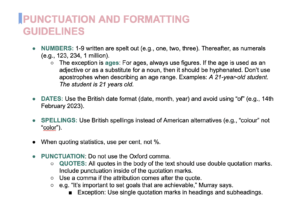Rose Morelli
Journalism can be a brutal business. Add this codified guide to your toolkit of journalistic survival skills to help you write an opinion piece for Empoword Journalism, and guide you in the industry beyond. We’ve even thrown in a little 101 on pitching, just for good measure. Lucky you!
What Does A Good Opinion Piece Look Like?
A good opinion piece (sometimes called an op-ed) strikes a balance between news reportage, academic analysis and emotion. In other words: you need to engage and entertain, as well as inform and argue.
Ultimately, you should treat opinion writing a bit like a marketing exercise: you need to sell your viewpoint concisely and interestingly.
Pitching An Opinion Piece

At Empoword, we aim to reply and provide feedback on every pitch we receive, even if we’re not taking the piece forward. However, this is not industry standard.
At the end of the day, editors are incredibly busy people; their inboxes are usually stuffed and they won’t always have the time to respond to your pitch.
Unfortunately, there’s no way to guarantee a successful pitch, but there are some things you can do to maximise your chances of being picked up.
1. NEVER SUBMIT A COMPLETED PIECE
Most, if not all outlets, will not accept completed submissions.
We understand that you’re full of good ideas and raring to get them out there, but an editor’s job is to guide you on tone, angle and form, and to keep you in line with the outlet’s ethos and style
It’s fine to have a very rough first draft of your piece ready before you pitch, but avoid sharing this before you’ve made significant edits based on an editor’s suggestions.
You need to be prepared for guidance that might go against your own writing preferences. This is not personal, it’s just good business!
2. KEEP IT SHORT AND SNAPPY
If you submit a pitch that looks like War and Peace, an editor probably won’t have the time to parse your idea with a fine tooth comb.
Respect their time by condensing your idea into a pamphlet rather than an essay. If an editor sees your idea and wants more information, they’ll usually ask follow up questions.
A good rule of thumb is 200-300 words. Always include “Pitch” followed by your proposed headline in the subject, and try and bullet point your last 100-150 words. I tend to use this rough structure for my pitches:
Subject: “PITCH: SAUSAGE ROLLS ARE IDIOT FOOD — ALL HAIL THE STEAK BAKE”
(100-150 words) A brief summary of why you hate sausage rolls / love steak bakes, and why it matters. Try to show a little flair in these 100 words and sell the article with a fun, engaging opening line!
(100-150 words) In bullet points, briefly explain in more detail what points you’ll make. Remember, if you can’t concisely explain your argument at pitching stage, you run the risk of getting lost while writing the article. Take some time to consider your argument before you pitch.
3. EXPLAIN WHY YOUR ARTICLE IS A GOOD FIT FOR THE OUTLET
Make it obvious to the editor why your piece is a unique fit for their outlet.
The topic, angle, and writing style will vary, depending on the publication you’re writing for — a New Statesman piece, for example, will allow for a more academically-slanted analysis than an article for Glamour.
You can even dedicate a sentence of your pitch to explaining exactly why your idea is a perfect fit for the outlet.
4. CONCISELY SELL YOURSELF
At the opening or close of your email, briefly sum up your journalistic experience — one sentence is more than enough. You can also hyperlink your portfolio, or a previous article on a related topic to your pitch.
Stuff That Makes Opinion Editors Sad

1. STRAIGHT UP LIBEL
If you write something about a person or organisation that could cause harm to their reputation, you need to have legally admissible evidence for what you’re alleging. Otherwise, it needs to be printed by another credible news source — if you can’t hyperlink a credible news source that backs up your point, we simply can’t publish it.
A good example of an article that stays on the right side of the law is this piece about Mason Greenwood, from our recently departed Head Opinion Editor (RIP Cara — gone but not forgotten).
Sexual assault allegations are a particularly difficult topic to navigate in terms of libel, but Cara (in conjunction with our Editors-In-Chief) did an amazing job of evidencing all included claims, and staying on the right side of the law.
2. NOT STICKING TO THE WORD COUNT
We have a maximum limit of 800 words for Opinion pieces at Empoword. We’re happy to accept 10 per cent (80 words) over or under the word count, but any submissions over that will be returned to the contributor before we can make further edits.
We advise that you exercise some editorial responsibility yourself by deciding which parts to cut: to write well is to self-edit often!
A really good example of a contributor who managed to condense a very dense, complex comment piece down to around 800 words is this article about Lucy Letby by Liv Thompson. Not only did she wrangle a very multi-faceted story into one digestible piece of writing, she was economic with how she used different information and contexts to make points.
3. OVER-EXPLAINING, AND NOT INCLUDING YOUR OWN OPINION UNTIL HALFWAY THROUGH
Is it important to set the scene for your argument? Absolutely. Are you going to put your readers off by spending the first 400 words on an intricate, academic history of your chosen topic? Definitely.
Most readers will decide within the first few paragraphs if they’re going to stick with your piece until the bitter end, so you need to be economic with how you use your first section.
This is most often a structural problem: instead of weaving information throughout and hinging it to your argument where it’s relevant, we see a bulk of raw data sitting at the top of your article.
A great example of an article that gets right to the point is this op-ed about Rishi Sunak by Emily Bird. As well as matching political knowledge with satirical humour, she wastes no time getting into the bare bones of her argument. She explains her hot take in the very first line, and weaves information throughout her piece as it becomes pertinent to her argument.
4. NOT ACCEPTING FEEDBACK
We know how hard you work to produce your submissions, and the last thing we want to do is undermine your voice as a writer. That said, journos often need guidance — regardless of how far along they are in their career.
Your personal writing voice isn’t always going to match with an outlet’s style, and it’s the editors job to brief you on that match. Edits should be part of an extended conversation, and of course, you are always welcome to discuss edits that you’re not sure about with the editor!
One great example of a writer who took our feedback on board is Niladri Singh, who produced this really fun article about women being demonised for partying. Her initial piece zeroed in on how Sophie Turner was being skewered by Joe Jonas’ PR team during their divorce, a topic we’d already recently covered on the site. We asked Niladri to use Turner as a springboard into a wider conversation, and she came back with this really thoughtful piece about wider media trends.
Stuff That Makes Opinion Editors Happy

1. TAILOR WORD CHOICE AND STRUCTURE
If you’ve chosen a fun, phatic topic like an online trend, use fun, referential language which reflects that! Equally, if you’re broaching heavier, more political topics, use stronger, more attritional language.
It can help to imagine yourself as a topic-relevant columnist depending on what you’re writing. If you’re writing about sex and relationships, then channel your inner Carrie Bradshaw!
“Think of it less like a lecture hall, and more like a pub conversation or letter to a friend”
Try to remember your target readers when choosing your topic. In the age of SEO journalism, a lot of readers are going to click on your article based on its topic, rather than the outlet itself. If you’re writing a piece about Ariana Grande for example, citing Das Kapital isn’t likely to go down with the article’s target audience.
A great example of an article that matches word choice to topic is this hilarious comment piece on the Gwyneth Paltrow skiing musical by Lucy Matthews. Lucy hits her readers with jokes as early as the headline, and her slapstick word choice throughout complement the subject matter. The result is an article that isn’t just funny in its punchlines, but its word choices and tone too.
2. USE ENGAGING, CONVERSATIONAL LANGUAGE
A good way to modulate your tone for an opinion piece is to think of it less like a lecture hall, and more like a pub conversation or letter to a friend. Aim for an informal, intimate conversation: like those fun, but still in-depth and informed conversations you have with friends.
A great example of a piece that uses humour and conversational language to its advantage is this article about TikTok “core” trends by Elisabetta Laurence. She straddles the line between academic terminology and eloquence well, inviting readers to enjoy her flowery language rather than exclude them with it.
3. HINGE A PIECE ON CURRENT EVENTS (AT EMPOWORD, WE LOVE FEMININE-SLANTED TOPICS)
Ah, those three mystical little letters. SEO, or “Search Engine Optimisation”: also known as the Internet Traffic Gods who grant sunlight to your piece.
Part of an editors job is to drum up traffic to your article and their outlet by picking SEO-friendly topics that will gather clicks and drive readers to the site.
What does this mean for you as a writer? It’s simple: it means we want your takes on trending topics and current affairs! The more people are talking about a subject, the more interest your article is going to receive — and that benefits both you and the outlet.
The best opinion pieces will link a popular topic to a more general discussion. Rather than describing your own opinion on the raw data of a trend, what do you think it says about a wider topic?
A great example of an op-ed that used a trending topic of the day to make a wider point was this article about Barbenheimer marketing by Sophie Johnson. By hinging her article to a traffic-heavy topic like Barbenheimer, Sophie was able to make a wider point about the revival of cinema.
4. CHECK THE HOUSE STYLE
You’ll melt an editor’s heart if you consult on house style for your piece before submitting — not only does this show you know the publication you’re writing for, but it saves them time and work.

A lot of outlets have a style guide ready to go on their website, and at Empoword we have our own style guide. Have a good look at our style guide and other articles on our site before submitting your piece.
We love to use subheadings at Empoword. We recommend adding these yourself before submitting, as we often receive pieces that don’t have space in their flow for subheading breaks. It’s better to structure your piece around your subheadings than have them added in retroactively by editors.
READ NEXT:
-
JOURNALISM RESOURCES AT EMPOWORD JOURNALISM
-
HOW TO BEFRIEND WRITERS’ BLOCK
-
NAVIGATING SENSITIVE REPORTING: A JOURNALIST’S GUIDE
Featured image courtesy of Steve Johnson via Unsplash. No changes made to this image. Image license found here.

